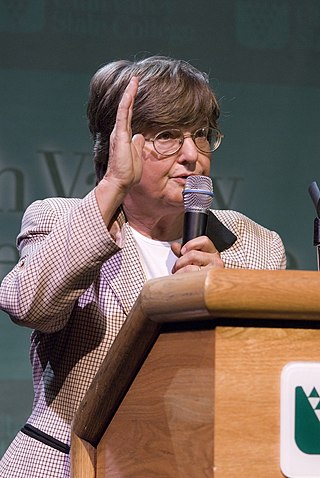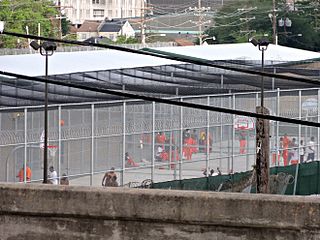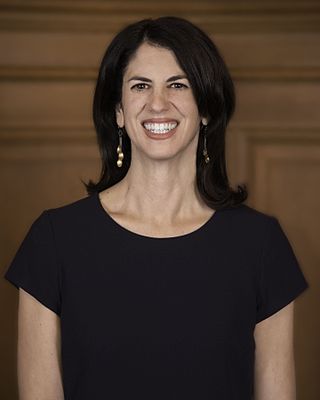Related Research Articles

Helen Prejean is a Catholic religious sister and a leading American advocate for the abolition of the death penalty.

Solitary confinement is a form of imprisonment in which the inmate lives in a single cell with little or no meaningful contact with other people. A prison may enforce stricter measures to control contraband on a solitary prisoner and use additional security equipment in comparison to the general population. Solitary confinement is a punitive tool within the prison system to discipline or separate disruptive prison inmates who are security risks to other inmates, the prison staff, or the prison itself. However, solitary confinement is also used to protect inmates whose safety is threatened by other inmates by separating them from the general population.

The prison-industrial complex (PIC) is a term, coined after the "military-industrial complex" of the 1950s, used by scholars and activists to describe the relationship between a government and the various businesses that benefit from institutions of incarceration.
Capital punishment in Canada dates back to Canada's earliest history, including its period as a French colony and, after 1763, its time as a British colony. From 1867 to the elimination of the death penalty for murder on July 26, 1976, 1,481 people had been sentenced to death, and 710 had been executed. Of those executed, 697 were men and 13 were women. The only method used in Canada for capital punishment of civilians after the end of the French regime was hanging. The last execution in Canada was the double hanging of Arthur Lucas and Ronald Turpin on December 11, 1962, at Toronto's Don Jail. The military prescribed firing squad as the method of execution until 1999, although no military executions had been carried out since 1945.

The prison abolition movement is a network of groups and activists that seek to reduce or eliminate prisons and the prison system, and replace them with systems of rehabilitation that do not place a focus on punishment and government institutionalization. The prison abolitionist movement is distinct from conventional prison reform, which is the attempt to improve conditions inside prisons.

Critical Resistance is a U.S. based organization that works to build a mass movement to dismantle what it calls the prison-industrial complex (PIC). Critical Resistance's national office is in Oakland, California, with three additional chapters in New York City, Los Angeles, and Portland, Oregon.
The National Coalition to Abolish the Death Penalty (NCADP) is a large organization dedicated to the abolition of the death penalty in the United States. Founded in 1976 by Henry Schwarzschild, the NCADP is the only fully staffed nationwide organization in the United States dedicated to the total abolition of the death penalty. It also provides extensive information regarding imminent and past executions, death penalty defendants, numbers of people executed in the U.S., as well as a detailed breakdown of the current death row population, and a list of which U.S. state and federal jurisdictions use the death penalty.

Capital punishment has been completely abolished in all European countries except for Belarus and Russia, the latter of which has a moratorium and has not conducted an execution since September 1996. The complete ban on capital punishment is enshrined in both the Charter of Fundamental Rights of the European Union (EU) and two widely adopted protocols of the European Convention on Human Rights of the Council of Europe, and is thus considered a central value. Of all modern European countries, San Marino, Portugal, and the Netherlands were the first to abolish capital punishment, whereas only Belarus still practises capital punishment in some form or another. In 2012, Latvia became the last EU member state to abolish capital punishment in wartime.

The Transgender Law Center (TLC) is the largest American transgender-led civil rights organization in the United States. They were originally California's first "fully staffed, state-wide transgender legal organization" and were initially a fiscally sponsored project of the National Center for Lesbian Rights. The stated mission of TLC is to connect transgender people and their families to technically sound and culturally competent legal services, increase acceptance and enforcement of laws and policies that support California's transgender communities, and work to change laws and systems that fail to incorporate the needs and experiences of transgender people. TLC utilizes direct legal services, public policy advocacy, and educational opportunities to advance the rights and safety of diverse transgender communities.

The Ella Baker Center for Human Rights is a non-profit strategy and action center based in Oakland, California. The stated aim of the center is to work for justice, opportunity and peace in urban America. It is named for Ella Baker, a twentieth-century activist and civil rights leader originally from Virginia and North Carolina.

Annual marches, protests or gatherings take place around the world for transgender issues, often taking place during the time of local Pride parades for LGBT people. These events are frequently organized by trans communities to build community, address human rights struggles, and create visibility.

Michael Hennessey was the longest serving Sheriff in the history of San Francisco and was the longest tenured Sheriff in the State of California. Hennessey was elected in a run-off election in December 1979 and had been reelected in seven subsequent elections.

London Nicole Breed is an American politician who is the 45th and current mayor of the City and County of San Francisco. She was supervisor for District 5 and was president of the Board of Supervisors from 2015 to 2018.

Orleans Parish Prison is the city jail for New Orleans, Louisiana. First opened in 1837, it is operated by the Orleans Parish Sheriff's Office. Most of the prisoners—1,300 of the 1,500 or so as of June 2016—are awaiting trial.

The Anarchist Black Cross (ABC), formerly the Anarchist Red Cross, is an anarchist support organization. The group is notable for its efforts at providing prisoners with political literature, but it also organizes material and legal support for class struggle prisoners worldwide. It commonly contrasts itself with Amnesty International, which is concerned mainly with prisoners of conscience and refuses to defend those accused of encouraging violence. The ABC openly supports those who have committed illegal activity in furtherance of revolutionary aims that anarchists accept as legitimate.

The San Francisco Bay Area comprises nine northern California counties and contains four of the ten most expensive counties in the United States. Strong economic growth has created hundreds of thousands of new jobs, but coupled with severe restrictions on building new housing units, it has resulted in an extreme housing shortage which has driven rents to extremely high levels. The Sacramento Bee notes that large cities like San Francisco and Los Angeles both attribute their recent increases in homeless people to the housing shortage, with the result that homelessness in California overall has increased by 15% from 2015 to 2017. In September 2019, the Council of Economic Advisers released a report in which they stated that deregulation of the housing markets would reduce homelessness in some of the most constrained markets by estimates of 54% in San Francisco, 40 percent in Los Angeles, and 38 percent in San Diego, because rents would fall by 55 percent, 41 percent, and 39 percent respectively. In San Francisco, a minimum wage worker would have to work approximately 4.7 full-time jobs to be able to spend less than 30% of their income on renting a two-bedroom apartment.
The California Prison Moratorium Project is a grassroots organization co-founded by Dr. Ruth Gilmore, involved in Prison Abolition through Critical Resistance, and Ernesto Saveedra, a youth advocate, for the purpose of stopping "all public and private prison construction in California." Over its activist life, the CPMP has partnered with a number of groups including Critical Resistance, The California Coalition for Women Prisoners, Californians United for a Responsible Budget (CURB), and many other abolitionist organizations to move forward in their goal of halting any erection of additional penal facilities within the state of California. An example of their collective success is demonstrated in such cases as the 2001 prevention of a new Delano Prison where anti-prison activists such as the CPMP swayed public opinion away from yet another jail.

Hillary Ronen is an American politician and attorney serving as a member of the San Francisco Board of Supervisors from District 9, which includes the neighborhoods of Mission District, Bernal Heights, and Portola.

Janetta Louise Johnson is an American transgender rights activist, human rights activist, prison abolitionist, and transgender woman. She is the Executive Director of the TGI Justice Project. She co-founded the non-profit TAJA's Coalition in 2015. Along with Honey Mahogany and Aria Sa'id, Johnson is a co-founder of The Transgender District, established in 2017. Johnson's work is primarily concerned about the rights and safety of incarcerated and formerly-incarcerated transgender and gender-non-conforming people. She believes that the abolition of police and the prison industrial complex will help support the safety of transgender people, and she identifies as an abolitionist.

Decarceration in the United States involves government policies and community campaigns aimed at reducing the number of people held in custody or custodial supervision. Decarceration, the opposite of incarceration, also entails reducing the rate of imprisonment at the federal, state and municipal level. Home to 5% of the global population but 25% of its prisoners, the U.S. possess the world's highest incarceration rate: 655 inmates for every 100,000 people, enough inmates to equal the populations of Philadelphia or Houston. The COVID-19 pandemic has reinvigorated the discussion surrounding decarceration as the spread of the virus poses a threat to the health of those incarcerated in prisons and detention centers where the ability to properly socially distance is limited.
References
- 1 2 3 4 5 Donahue, Jayden, and Jess Heaney. No New Jail in San Francisco. N.p. Web.http://criticalresistance.org/wp-content/uploads/2015/05/SFJF-CR_PeoplesReport_WEB.pdf
- ↑ "No new jail after S.F. supervisors refuse to allocate funds". SFGate. Retrieved 2016-05-06.
- ↑ "San Francisco: Supervisors vote against using state funds to build a new jail". www.mercurynews.com. Retrieved 2016-05-06.
- 1 2 Gido, Rosemary L. "TRENDS IN JAIL ADMISSIONS RATES." American Journal of Criminal Justice 14.1 (1989): 1. Print.
- ↑ Capron, Alexander M. "Medical Research in Prisons." The Hastings Center Report 3.3 (1973): 4–6. Web.
- ↑ Nagel, William G."A Statement on Behalf of a Moratorium on Prison Construction." Prison Journal 56.2 (1976): 32. Print
- 1 2 Nagel, William G. "A Moratorium On Correctional Construction." Prison Journal 52.2 (1972): 66–72. Web.
- ↑ Immarigeon, Russ. "The Context of Jail Litigation in the United States." Prison Journal 70.2 (1990): 12. Print.
- ↑ DiIulio, John J. "Federal Crime Policy: Time for a Moratorium." The Brookings Review 17.1 (1999): 17–21. Web.
- ↑ Perrello, Stephen Joseph. "Jail Expansion, Why? A Case Study of San Diego County, California, 1975--1995." Ph.D. Rutgers The State University of New Jersey - Newark, 2000. ProQuest. Web. 12 Mar. 2016.